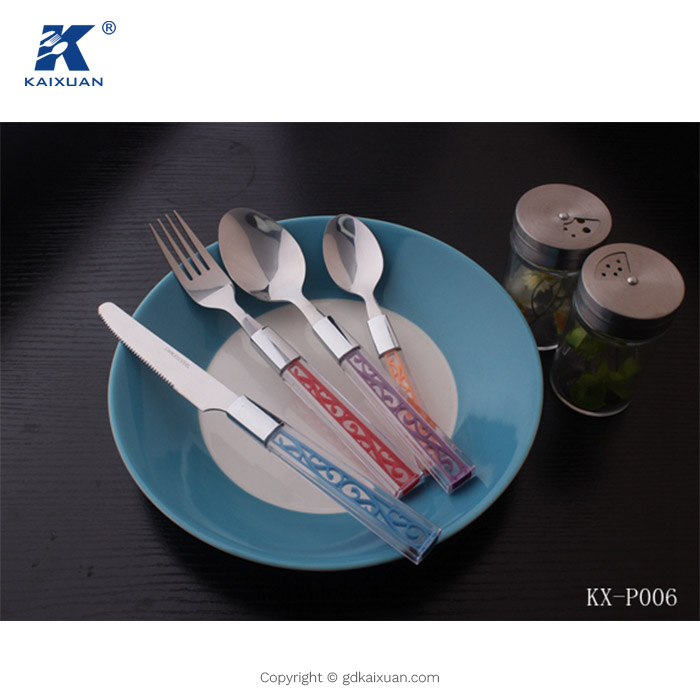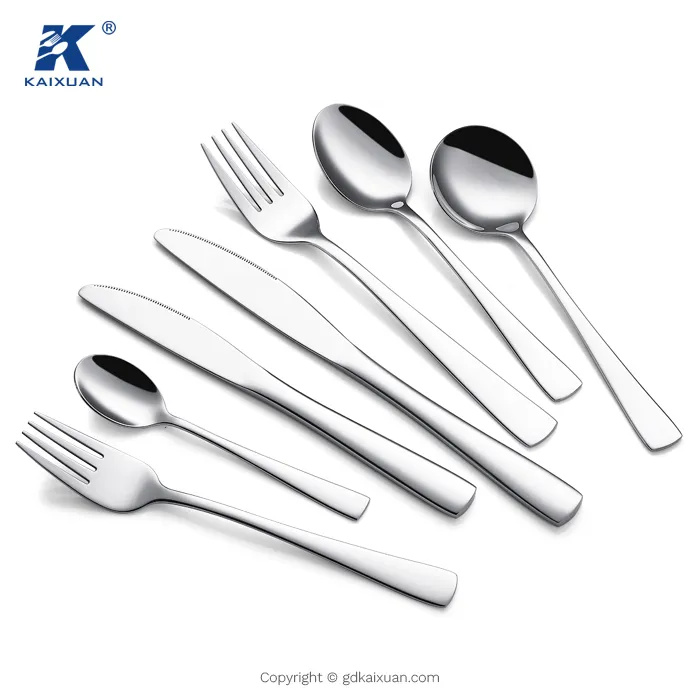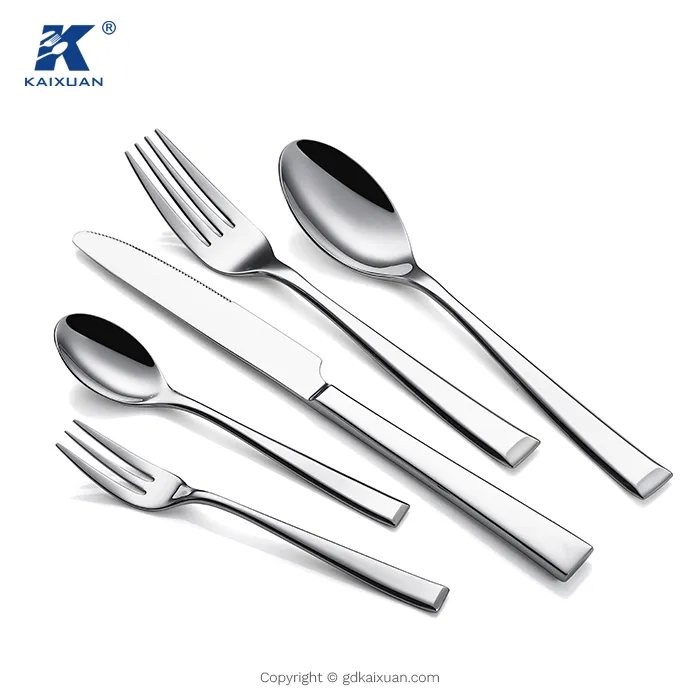Bulk Stainless Cutlery Set
Discover our factory-direct Bulk Stainless Cutlery Set! Explore a diverse range of styles, customizable to suit your needs. Enjoy unbeatable prices for premium quality. Shop now for great deals!
معلومات عنا
تقع Jieyang Kaixuan Stainless Steel Industrial Co.، Ltd في منطقة صناعية Meipan بمدينة Meiyun بمقاطعة Rongcheng بمدينة Jieyang بمقاطعة Guangdong، وتغطي مساحة تبلغ 10000 متر مربع.
شركتنا متخصصة في تصميم وإنتاج وبيع أدوات المائدة من الفولاذ المقاوم للصدأ وأدوات المائدة ذات المقابض البلاستيكية وأدوات المطبخ والأواني وغيرها من المنتجات المعدنية لأكثر من 10 سنوات. نحن نركز على الإدارة ومراقبة الجودة مع إدارة ذات خبرة وقدرات تكنولوجية قوية وإنتاجية عالية المستوى.
نرحب صادقين بالأصدقاء من جميع أنحاء العالم في شركتنا ونؤسس تعاونًا مربحًا للجانبين.

About Stainless Steel Cutlery
Types of Stainless Steel Cutlery
The primary function of stainless steel cutlery is to serve as practical tools for dining and food preparation. However, their unique characteristics contribute to their appeal among consumers. One of the most significant factors is the composition of the materials used. Generally, stainless steel cutlery can be categorized into three main types based on their material properties:
- High Carbon Stainless Steel
This variety of stainless steel is renowned for its exceptional hardness and ability to retain a sharp edge, a result of its higher carbon content. It is particularly suited for those who skillfully handle their cutlery, although it is more prone to rust if not maintained properly.
- Stainless Steel
Stainless steel is a widely favored option due to its ease of maintenance and cleaning. This corrosion-resistant alloy, composed of chromium, iron, and nickel, offers durability while resisting rust and stains, making it an excellent choice for those seeking reliable and long-lasting cutlery.
- Forged Stainless Steel
Forged stainless steel cutlery undergoes a manufacturing process where the steel is subjected to extreme pressure, resulting in a denser and stronger material compared to standard stainless steel. This type of cutlery is ideal for individuals desiring knives that remain sharp and endure the test of time.
In addition to material composition, stainless steel cutlery can also be classified based on functionality and intended use. This classification emphasizes the purpose of each utensil rather than the materials from which they are made. Common types include:
- Knives
Stainless steel knives are among the most prevalent utensils in any kitchen. Various types are designed for specific tasks; while many use them for slicing, chopping, or dicing, others have particular applications such as paring, peeling, and trimming.
- Forks
Forks are another staple in stainless steel cutlery. Different varieties serve various purposes: dinner forks are typically used for main courses, dessert forks for sweets and fruits, and salad forks for appetizers and salads.
- Spoons
Similar to forks, there is a range of spoons available in stainless steel. Teaspoons are commonly used for both solid and semi-solid foods, while dessert spoons cater specifically to sweets. Additionally, stainless steel serving spoons are available for serving dishes.
Beyond these common types, several other forms of stainless steel cutlery are worth mentioning:
- Cleavers
Cleavers are robust, rectangular knives designed to cut through bones and large pieces of meat. Their weight and sturdiness make them ideal for butchering tasks.
- Peeling Knives
These small knives feature curved blades specifically crafted for peeling fruits and vegetables with ease.
- Steak Knives
Steak knives are sharp, compact knives typically placed on dining tables for cutting steak and similar cuts of meat.
- Utility Knives
Utility knives are versatile tools suitable for a variety of tasks, including cutting, slicing, and paring, making them indispensable in any kitchen.
Design of Stainless Steel Cutlery
- مادة
Stainless steel cutlery is crafted from a metal alloy comprised of iron, chromium, nickel, and carbon. The presence of chromium is what imparts the ‘stainless’ quality to the steel, rendering it resistant to rust and corrosion.
- Construction
The construction of stainless steel cutlery typically involves either forging, stamping, or a combination of both techniques. Forging entails shaping the metal by hammering it into the desired form, while stamping employs dies to cut and shape the metal precisely. The cutting edges of knives and other utensils are subsequently sharpened to facilitate effective cutting tasks.
- Tines on Forks
The tines of forks are engineered to be robust enough to skewer food items securely during dining. They are usually designed with blunt tips for safety, minimizing the risk of injury while eating.
- Spoons vs. Knives
Knives feature a sharp edge that allows for cutting or slicing actions, making them essential for food preparation. Forks, equipped with multiple tines, serve the purpose of piercing and spearing foods. Meanwhile, spoons possess a rounded, bowl-like shape ideal for scooping liquids or soft foods. Each utensil is carefully designed to effectively handle various types of foods during meals.
- Handles
The handles of knives are created by attaching materials such as wood, plastic, or metal to the tang of the knife using rivets or adhesives. For forks and spoons, the stainless steel is shaped during the stamping process into an ergonomic form that allows for a comfortable grip.
- Design Aspects
Cutlery designers consider several factors, including ergonomics, aesthetics, and functionality, when creating stainless steel cutlery. Ergonomics ensures that handles are comfortable to hold and use. Aesthetics pertain to the visual appeal of the cutlery, encompassing style, color, and finish. Functionality guarantees that each piece performs its intended purpose effectively, with knives remaining sharp, forks possessing strong tines, and spoons being capable of holding liquids and soft foods.
Scenarios for Stainless Steel Cutlery
Stainless steel cutlery is versatile and suitable for a variety of settings, both formal and informal.
- Formal Dining
Formal dining refers to an elegant eating experience, often characterized by guests dressing in their finest attire and a special meal being served. In such settings, stainless steel cutlery is preferred for its sophisticated appearance and shiny finish. A well-arranged table with various knives, forks, and spoons reflects class and refinement, making it ideal for significant occasions like weddings, anniversaries, or distinguished dinners.
- Professional Catering
Professional caterers rely on stainless steel cutlery to ensure both quality and safety when serving food at events. The cutlery withstands frequent handling and washing, essential in the bustling environment of catering. Its design accommodates a wide range of dishes, from appetizers to desserts, making it suitable for various events, including conferences, parties, and weddings.
- Outdoor Dining
Stainless steel cutlery is also a popular choice for outdoor dining experiences such as picnics, barbecues, and camping trips. Its durability and easy-to-clean nature make it an excellent option for outdoor settings. Resistant to dirt, dust, and moisture, it will not rust or corrode, providing reliability for al fresco meals. The lightweight and portable design of knives, forks, and spoons further enhances their suitability for outdoor use.
- Everyday Home Use
In households, stainless steel cutlery is a staple for daily meals, whether it be breakfast, lunch, or dinner. Designed for regular use, this cutlery is robust, easy to handle, and safe for all family members. Many prefer stainless steel over other materials due to its non-toxic properties and compatibility with various foods.
How to Choose Stainless Steel Cutlery
Stainless steel is a widely used material for crafting spoons, knives, and forks. When selecting stainless steel cutlery, several key factors should be taken into account:
- Purpose and Usage
Understanding the intended use of the cutlery is paramount. Will it be employed for everyday dining, special occasions, outdoor activities, or professional kitchen settings? For example, if the cutlery is intended for outdoor pursuits, durability and ease of maintenance become essential considerations. Conversely, for a professional kitchen, one might prioritize sharpness and versatility.
- Quality of Stainless Steel
Seek out high-quality stainless steel with a reputable grade. As previously mentioned, 18/10 stainless steel, also known as 304, is among the most rust-resistant and durable options available. This material effectively resists corrosion and maintains its luster over time.
- Construction and Craftsmanship
Examine the construction and craftsmanship of the cutlery. A solid build using quality materials is crucial for ensuring durability and performance. For knives, full-tang construction—where the blade extends through the handle—is a clear indicator of superior quality.
- Design and Aesthetics
Select a design that resonates with your personal preferences and complements your dining experience. Whether you lean towards sleek, modern lines or prefer intricate, traditional designs, there is a vast array of options to choose from.
- Maintenance and Care
While stainless steel cutlery is generally easy to maintain, it is wise to consider specific care instructions. Opt for cutlery that does not require special maintenance to ensure it retains its appearance and functionality over time.
- Budget
Establish your budget and strive to find a balance between quality and cost. Remember, investing in high-quality cutlery can yield long-lasting benefits and greater value over the years.
- Set vs. Individual Pieces
Decide whether to purchase a complete cutlery set or individual pieces. Cutlery sets offer a comprehensive solution for dining, while acquiring individual pieces allows for greater customization, enabling you to select only the items you require.
What is the minimum order requirement for bulk silverware?
Q1: What distinguishes stainless steel cutlery from other materials?
A1: Stainless steel cutlery is constructed from an iron-based alloy with chromium as its primary ingredient. The inclusion of chromium is what makes the cutlery resistant to stains and rust.
Q2: What is the significance of the grades in stainless steel?
A2: The grades denote different formulations of stainless steel, each possessing unique properties tailored for various applications.
Q3: What role does chromium play in stainless steel?
A3: Chromium forms a protective layer that prevents oxidation, thereby imparting stainless steel with its rust-resistant qualities.
Q4: Why is durability important in cutlery?
A4: Durability ensures that knives, forks, and spoons can endure daily usage without the need for frequent replacement, rendering them a cost-effective choice in the long term.
Q5: Why is the easy-to-clean feature of stainless steel significant?
A5: This characteristic is essential for maintaining hygiene, ensuring that the cutlery consistently appears clean and presentable.
Q6: What does it mean for stainless steel to be resistant to rust and corrosion?
A6: This means that even when the cutlery is exposed to moisture or acidic foods, it will not develop rust or corrosion, thereby ensuring its longevity.
Q7: Which is superior, 304 or 316 stainless steel?
A7: Both are excellent choices, but 316 stainless steel contains higher levels of molybdenum, which enhances its resistance to salt corrosion.
Q8: How can one identify if cutlery is made of stainless steel?
A8: Look for a “stainless steel” marking or conduct a magnet test; genuine stainless steel will exhibit a consistent shine and will not be attracted to magnets.
Q9: Can stainless steel cutlery be used with all types of foods?
A9: Absolutely. Stainless steel cutlery is versatile and suitable for all food types, including those with acidic components.
Q10: Is stainless steel cutlery safe for health?
A10: Indeed. Stainless steel does not react with food and is considered one of the safest materials for cutlery.














































